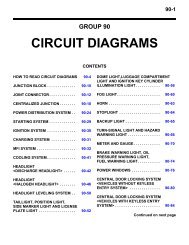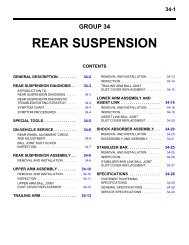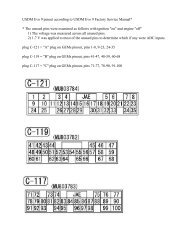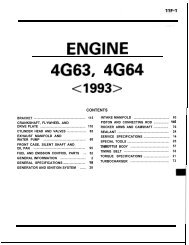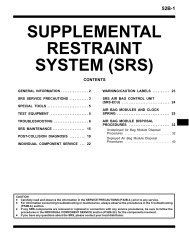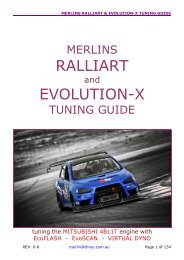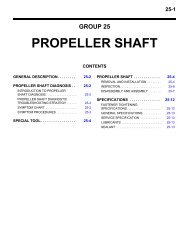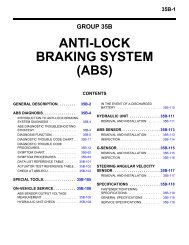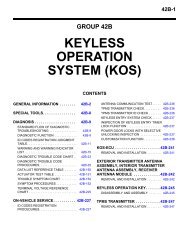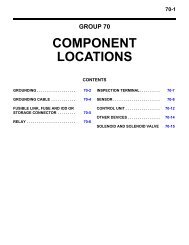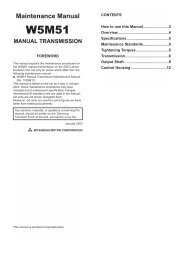LANCER EVOLUTION X Chassis Technologies - EvoScan
LANCER EVOLUTION X Chassis Technologies - EvoScan
LANCER EVOLUTION X Chassis Technologies - EvoScan
Create successful ePaper yourself
Turn your PDF publications into a flip-book with our unique Google optimized e-Paper software.
<strong>LANCER</strong> <strong>EVOLUTION</strong> X <strong>Chassis</strong> <strong>Technologies</strong><br />
Masaru OHUCHI* Takeshi YAMAMURA* Hiroshi OIKAWA*<br />
Abstract<br />
For the kind of driving pleasure targeted by Mitsubishi Motors Corporation with the <strong>LANCER</strong><br />
<strong>EVOLUTION</strong> X, the platform was updated and new chassis technologies were developed. The suspension<br />
was fundamentally revamped in terms of layout and structure and was combined with<br />
wider treads * and 18-inch wheels, resulting in exceptional roadholding at all four tires and in concomitantly<br />
improved cornering performance and a high-quality ride befitting the new-generation<br />
<strong>LANCER</strong> <strong>EVOLUTION</strong>. In addition, larger-diameter brakes were adopted for superior stopping power<br />
and fade resistance and a superior pedal feel.<br />
*: 30 mm wider than <strong>LANCER</strong> <strong>EVOLUTION</strong> IX<br />
Key words: Sport Car, Motor Sports, <strong>Chassis</strong>, Vehicle Dynamics, Steering System, Stability,<br />
Suspension System, Shock Absorber, Damping, Wheel Alignment, Brake, Tire, Wheel,<br />
Handling, Ride Comfort<br />
1. Introduction<br />
The <strong>LANCER</strong> <strong>EVOLUTION</strong> was developed as the<br />
base vehicle for rallies and other competitions, and has<br />
continued to evolve to the present. In recent years,<br />
however, there have arisen demands not only for high<br />
driving performance, but also for high-quality riding<br />
performance as well.<br />
This time, along with the renovation of the platform,<br />
the entire chassis has been newly developed, aiming at<br />
the simultaneous realization of enhanced handling stability<br />
and high-quality riding.<br />
2. Suspension<br />
The suspension was designed with the aim of<br />
increasing the rigidity of each part and also optimizing<br />
the geometry for secure positioning of wheels. Also, a<br />
highly rigid, lightweight suspension was developed by<br />
selecting the right material for the right place and optimizing<br />
its construction. In addition, the road holding<br />
performance was increased in order to maximize the<br />
effectiveness of the Super All Wheel Control (S-AWC)<br />
integrated vehicle dynamics control system.<br />
Fig. 1<br />
Front suspension<br />
2.1 Front suspension<br />
The front suspension was newly developed along<br />
with the evolution of the MacPherson strut which used<br />
the proven inverted strut (Fig. 1).<br />
To cope with the increased various inputs and the<br />
improved cornering performance due to the adoption<br />
of 18-inch low-profile tires, steps were taken to increase<br />
the size of the hub unit bearings, increase the stiffness<br />
of the upper insulator that supports the strut, and also<br />
extensively increase the stiffness of the sub-members<br />
which correspond to the framework structure of the suspension<br />
(Fig. 2 and Fig. 3).<br />
Fig. 2<br />
Front stiffness-enhancing component<br />
* <strong>Chassis</strong> Design Dept., Development Engineering Office<br />
34
<strong>LANCER</strong> <strong>EVOLUTION</strong> X <strong>Chassis</strong> <strong>Technologies</strong><br />
Fig. 3<br />
Front stiffness-enhancing component<br />
Fig. 5<br />
Rear arm layout<br />
Fig. 4<br />
Rear suspension<br />
2.2 Rear suspension<br />
A completely new suspension was developed which<br />
has a sub-member conforming to the new platform<br />
while following the design of the proven multi-link type<br />
used on the <strong>LANCER</strong> <strong>EVOLUTION</strong> IX.<br />
The sub-member was connected securely to the<br />
body at six points, and the sub-member itself was also<br />
of a high-stiffness construction (Fig. 4).<br />
Regarding the suspension arms, the support span<br />
between each arm was enlarged, the length and layout<br />
of the arms were made appropriate, and the high stiffness<br />
and change of alignment were optimized (Fig. 5<br />
and Fig. 6). The hub unit bearing was also enlarged,<br />
resulting in greater stiffness (Fig. 7).<br />
Excellent road holding performance was realized by<br />
increasing the number of places where pillow balls<br />
were used and also by changing the mounting position<br />
of the rear damper from the lower arm to the knuckle<br />
(Fig. 4 and Fig. 7).<br />
By thus optimizing the construction of the suspension<br />
and increasing its stiffness, the handling stability -<br />
consisting of cornering limit, response and so on - and<br />
the riding performance - consisting of straight stability,<br />
riding comfort and so on - were simultaneously realized<br />
with relatively little compromise.<br />
Fig. 6<br />
2.3 Power steering system<br />
A hydraulic assist system was employed. By optimizing<br />
the assist characteristics and the steering gear<br />
ratio, a quick and high quality steering feeling was realized.<br />
3. Tires and wheels<br />
Rear suspension characteristics<br />
3.1 Tires<br />
245/40R18 low-profile wide tires were used. The<br />
necessary performance factors for high performance<br />
tires, consisting of handling stability, braking performance,<br />
wet performance, and quietness, were well-balanced<br />
against each other due to the newly developed<br />
asymmetrical tread pattern and the optimized inner<br />
structure.<br />
35
<strong>LANCER</strong> <strong>EVOLUTION</strong> X <strong>Chassis</strong> <strong>Technologies</strong><br />
Fig. 7<br />
Rear stiffness-enhancing component<br />
Fig. 8<br />
Fade resistance during sport driving<br />
3.2 Aluminum wheels<br />
The rims of the aluminum wheels were processed<br />
by spinning process for increased material strength<br />
while reducing their thickness and weight. In addition,<br />
the rim shape and location of the spokes were optimized<br />
for highly rigid and lightweight wheels.<br />
4. Brakes<br />
4.1 Wheel brakes<br />
The front brakes were 18 inches and the rear brakes<br />
were 17 inches, 1 inch larger than those for the <strong>LANCER</strong><br />
<strong>EVOLUTION</strong> IX. The outer diameter of the rotor was set<br />
to φ 350 mm for the front brakes, and φ 330 mm for the<br />
rear brakes, thus increasing the fading resistance and<br />
effectiveness of brakes (Fig. 8). In addition, the caliper<br />
mounting rigidity and the characteristics and shapes of<br />
the pad and rotor were optimized for the reduction of<br />
squealing and judder (Fig. 8).<br />
4.2 Highly rigid vacuum booster<br />
Aiming at improving biting feeling at the initial<br />
braking stage, a linear increase in braking force, and<br />
enabling of an increase in the braking force when the<br />
brake pedal is depressed further in the high G deceleration<br />
zone, a through-bolt type 10-inch vacuum booster<br />
was adopted together with improving the wheel<br />
brake performance. By reducing the internal sliding<br />
resistance due to the adoption of a single booster and<br />
by suppressing the shell deformation due to the use of<br />
a through-bolt, reduced friction feel, reduced pedal<br />
effort at high fluid pressure, and higher rigidity were<br />
realized, enhancing the braking control performance<br />
(Fig. 9).<br />
5. High performance items for MR grade<br />
In order to realize higher performance, Bilstein<br />
dampers, Eibach coil springs, and 18-inch two-piece<br />
front disc rotors, were made available as MR grade.<br />
Fig. 9<br />
5.1 Bilstein dampers and eibach coil springs<br />
The reputable Bilstein monotube permits fine tuning<br />
of damping characteristics from the ultra-low speed<br />
range. Furthermore, coupled with the Eibach coil<br />
spring, it realizes a pliable suspension with good road<br />
holding performance (Fig. 10).<br />
5.2 Two-piece disc rotor<br />
It is a two-piece construction consisting of a separate<br />
friction rotor and hub mounting bell. Compared to<br />
a single piece construction, the weight of each rotor has<br />
been reduced by 1.3 kg. A floating construction in<br />
which the rotor and the bell are bolted together via a<br />
spacer is employed, and also the shape has been optimized,<br />
minimizing coning angle of the friction surface<br />
at high temperature and realizing good braking stability<br />
(Fig. 11).<br />
6. Summary<br />
High-rigidity vacuum booster<br />
It is expected that in the future demands will continue<br />
to be made for further increases in the level of chassis<br />
technology for the <strong>LANCER</strong> <strong>EVOLUTION</strong>, concerning<br />
which high targets have been set and realized for<br />
each generation.<br />
36
<strong>LANCER</strong> <strong>EVOLUTION</strong> X <strong>Chassis</strong> <strong>Technologies</strong><br />
Fig. 10 Bilstein damper, Eibach coil spring Fig. 11 Two-piece disc brake rotor<br />
The <strong>LANCER</strong> <strong>EVOLUTION</strong> is Mitsubishi Motors’<br />
leading car. To ensure that it also remains a leading car<br />
in the automobile industry, efforts aimed at technical<br />
innovation will continue to be made in the future.<br />
Masaru OHUCHI Takeshi YAMAMURA Hiroshi OIKAWA<br />
37




